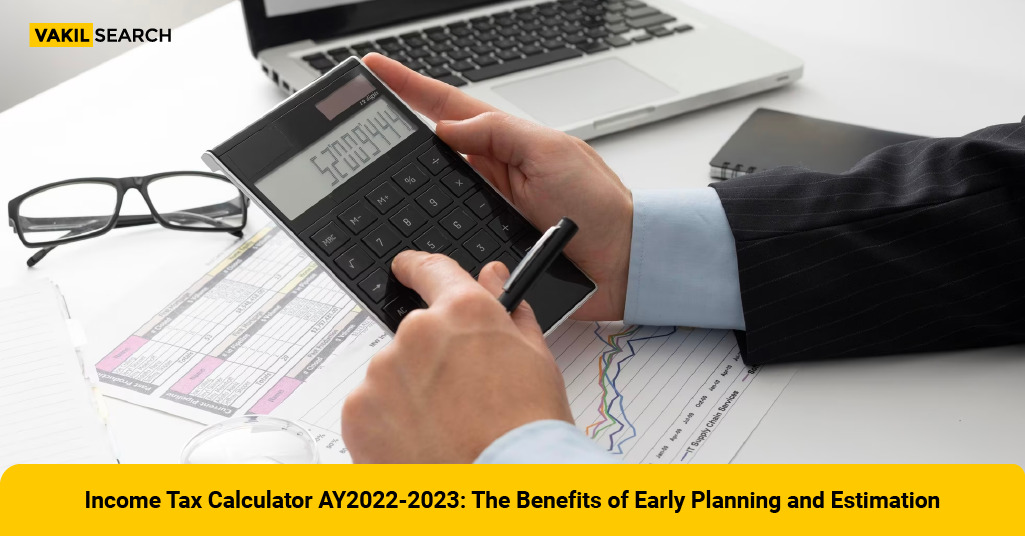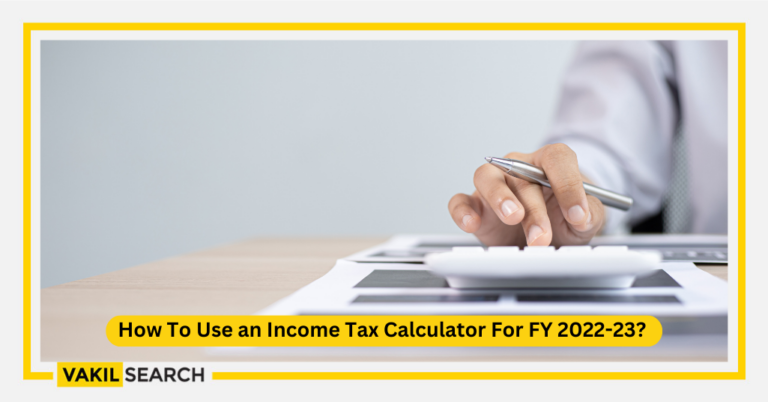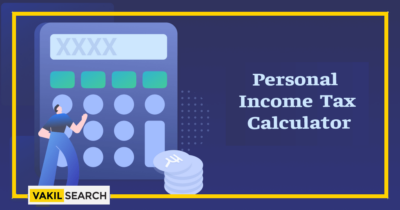Plan your taxes wisely! Explore the benefits of early Income Tax planning using AY 2023-24 Calculator. Secure your financial goals.
Overview
The Income Tax Calculator AY 2023-2024, an accessible online tool, facilitates the estimation of taxes based on one’s income post the Union Budget announcement. Regularly updated to align with income tax changes proposed in the Union Budget 2023-24, this tool provides a straightforward process for calculating taxes for the financial year 2023-24 (Assessment Year 2024-25). To use the Income Tax Calculator, begin by selecting the relevant financial year and noting your age, as tax liabilities in India differ across age groups. After this, proceed to the next step. Enter your taxable salary, which accounts for exemptions like HRA and LTA, to determine your tax liability under the old tax slabs.
Alternatively, if you prefer to know your tax liability under the new tax slabs, input your salary without availing of exemptions like HRA, LTA, and professional tax. The calculator also accommodates details such as interest income, rental income, and net income from Digital Assets. Following these entries, proceed to the next step. If you wish to calculate taxes under the old tax slabs, provide information on your tax-saving investments under sections 80C, 80D, 80G, 80E, and 80TTA. Click ‘Calculate’ to obtain your tax liability, with the benefit of comparing your pre-budget and post-budget tax liabilities under both old and new tax slabs. It’s important to note that for fields not applicable to you, simply enter 0.
The Income Tax Calculator is like an easy-to-use online helper that figures out how much tax you might owe based on your income after the government talks about the budget. They’ve made it match the new rules from the Union Budget in 2023-24. Here’s how to use it for the year 2023-24:
- Pick the year you want to calculate taxes for.
- Say how old you are because tax rules change with age.
- Click ‘Next.’
- Type in your salary after taking away things like HRA and LTA. This helps figure out tax under the old rules. Or, if you want to know tax under the new rules, just type your salary without these deductions.
- Add other money details, like interest and rent.
- Click ‘Next’ again.
- If you want to know taxes under the old rules, put in details about your tax-saving investments.
- Click ‘Calculate’ to see your tax. You can also compare it before and after the budget changes.
- Remember, if something doesn’t apply to you, just put 0. You can even get your tax info sent to your email. It’s like taxes made simple!
Significance of Planning for Income Tax
In India, figuring out your income tax is a crucial part of managing your finances. Tax planning isn’t just about dealing with numbers; it’s about making smart decisions to save money legally. It involves considering your savings, investments, and financial goals. Using tools like the income tax calculator can help you understand how much tax you owe and explore different plans to minimise your tax liability while staying within the bounds of the law. This planning is essential for both individuals and businesses, ensuring that you benefit from available tax benefits and navigate the complex landscape of tax laws.
Benefits of Early Planning with the Income Tax Calculator
When it comes to income tax, early planning is like a secret weapon. Using tools like the income tax calculator in advance can help you make informed decisions about your finances. It’s not just about paying less tax; it’s about aligning your financial goals with legal compliance. Early planning allows you to optimise your savings, investments, and tax liability, ensuring that you make the most of available benefits. By starting early, you can steer clear of last-minute stress and make strategic choices that suit your individual or business needs.
Step-by-Step Guide to Using the Income Tax Calculator:
Using an income tax calculator can be a helpful tool to estimate your tax liability and plan your finances accordingly. Here’s a step-by-step guide to using an income tax calculator:
1. Gather Necessary Information: Collect all relevant financial information, including your total income, deductions, exemptions, and other details required for tax calculation.
Key information includes your salary, business income, rental income, investment income, deductions like HRA (House Rent Allowance), standard deduction, and exemptions like HRA exemption, etc.
2. Choose a Reliable Income Tax Calculator: There are various income tax calculators available online. Choose a reliable one, preferably from a government or reputable financial website.
3. Select the Assessment Year: Ensure that you are using the income tax calculator for the correct assessment year, as tax rules may change from year to year.
4. Input Personal Information: Enter personal details such as your age, residential status, and other relevant information.
5. Enter Income Details: Input your total income. Depending on the calculator, you may need to provide details for different sources of income such as salary, business income, capital gains, etc.
6. Deductions and Exemptions: Include details of deductions and exemptions you are eligible for. Common deductions include those under Section 80C (like PF, PPF, Life Insurance Premiums, etc.), 80D (Health Insurance Premiums), and others.
7. Include Taxable Allowances: If applicable, input details of taxable allowances like HRA, LTA (Leave Travel Allowance), etc.
8. Taxable Income Calculation: The calculator will automatically compute your taxable income based on the information provided.
9. Select Tax Regime: Choose between the old and new tax regimes, as applicable. The new regime has lower tax rates but eliminates many deductions and exemptions.
10. Calculate Tax Liability: After entering all the required details, the calculator will compute your tax liability based on the applicable tax rates.
11. Check Results and Analysis: Review the detailed analysis provided by the calculator. This may include a breakup of your income, deductions, exemptions, and the final tax liability.
12. Save or Print Results: Some calculators allow you to save or print the results. This can be useful for future reference or when discussing your tax planning with a financial advisor.
13. Understand the Summary: Understand the summary of your tax calculation. This may include details on tax payable, refundable, or any additional tax liability.
Remember, while income tax calculators are helpful for estimation, they are not a substitute for professional tax advice. For complex financial situations or if you have doubts, it’s advisable to consult with a tax professional or financial advisor.
Common Mistakes to Avoid in Tax Planning:
Tax planning is crucial for optimising your financial situation and minimising your tax liability. However, there are common mistakes that individuals often make in the process. Here are some pitfalls to avoid in tax planning:
1. Procrastination:
Mistake: Waiting until the last minute to start tax planning.
Avoidance: Plan your taxes well in advance to have enough time to explore all available options and make informed decisions.
2. Ignoring Changes in Tax Laws:
Mistake: Failing to stay updated on changes in tax laws.
Avoidance: Regularly review tax regulations to ensure your strategies align with the current laws. Tax laws can change, impacting deductions, exemptions, and credits.
3. Overlooking Deductions and Credits:
Mistake: Not taking advantage of available deductions and credits.
Avoidance: Be aware of all eligible deductions and credits, such as those for education expenses, home ownership, and energy-efficient improvements.
4. Not Considering Long-Term Goals:
Mistake: Focusing solely on short-term tax benefits.
Avoidance: Consider the long-term impact of your tax decisions on your overall financial goals, including retirement planning and wealth accumulation.
5. Ignoring Retirement Planning:
Mistake: Neglecting opportunities for tax-advantaged retirement accounts.
Avoidance: Maximise contributions to retirement accounts like 401(k)s or IRAs to benefit from tax deferral or deductions.
6. Misunderstanding Tax Brackets:
Mistake: Incorrectly assessing the impact of tax brackets on income.
Avoidance: Understand how tax brackets work to optimise your income and deductions for the most tax-efficient outcome.
7. Not Keeping Proper Records:
Mistake: Failing to maintain accurate financial records.
Avoidance: Keep detailed records of income, expenses, and receipts. This ensures you can substantiate your claims in case of an audit.
8. Ignoring State Taxes:
Mistake: Focusing only on federal taxes and neglecting state taxes.
Avoidance: Be aware of state-specific deductions, credits, and tax rates that can impact your overall tax liability.
9. Relying Solely on Software:
Mistake: Blindly relying on tax software without understanding the calculations.
Avoidance: Use tax software as a tool, but also seek to understand the underlying principles of your tax situation.
10. Not Seeking Professional Advice:
Mistake: Assuming you can handle complex tax situations without professional help.
Avoidance: Consult with a tax professional or financial advisor, especially for intricate tax scenarios or major financial decisions.
11. Ignoring Estate Planning:
Mistake: Neglecting to plan for the tax implications of your estate.
Avoidance: Incorporate estate planning into your overall tax strategy, considering inheritance tax, gift tax, and other relevant factors.
12. Underestimating the Importance of Timing:
Mistake: Failing to time income and deductions optimally.
Avoidance: Understand the timing of income recognition and deduction eligibility to maximise tax benefits.
By avoiding these common mistakes, you can enhance the effectiveness of your tax planning and potentially reduce your tax burden. Always seek professional advice when needed to ensure that your strategies align with your financial goals and comply with current tax laws.
Importance of Estimation in Income Tax Planning
1. Financial Planning:
Strategic Decision-Making: Estimating income tax helps individuals and businesses make strategic financial decisions. It allows for better planning of expenditures, investments, and savings based on the expected tax liability.
Expense Management: By having a clear estimate of your tax liability, you can incorporate this into your budget. This ensures that you allocate funds for tax payments, preventing last-minute financial strain.
Prevent Overpayment or Underpayment: Estimating income tax helps you avoid surprises when tax season arrives. It ensures that you neither overpay nor underpay your taxes, leading to a more accurate financial picture.
Strategic Use of Tax Breaks: Through estimation, you can identify opportunities to optimise deductions and credits. This might involve timing certain expenses or investments to maximise tax benefits.
Adjusting to Life Changes: Estimation becomes crucial during significant life changes such as marriage, having children, or retirement. It allows you to proactively plan for the tax implications of these changes.
Adapting to Regulatory Changes:
Staying Compliant: Tax laws can change, impacting the calculation of taxes. Regular estimation ensures that you stay compliant with the latest regulations, helping you avoid penalties and legal issues.
Aligning with Goals: Estimating income tax aids in aligning investment strategies with tax objectives. For example, choosing tax-efficient investments or taking advantage of tax-saving investment options.
Profitability Analysis: For businesses, estimating income tax is integral to profitability analysis. It helps in assessing the impact of taxes on the bottom line and strategising for tax-efficient operations.
Cash Flow Management
Ensuring Adequate Cash Reserves: Knowing your estimated tax liability allows for better cash flow management. It ensures that you have sufficient funds available to meet your tax obligations when they become due.
Minimising Stress
Reducing Financial Stress: Accurate estimation reduces the stress associated with uncertainties in tax payments. It provides a sense of financial control and predictability.
Future Planning
Setting Future Goals: Estimation is a forward-looking activity. It helps in setting realistic financial goals and allows for better long-term planning, whether for major purchases, education expenses, or retirement.
Tax-Saving Strategies for the Upcoming Assessment Year
1. Utilise Section 80C Deductions: Maximise contributions to tax-saving instruments under Section 80C, such as Employee Provident Fund (EPF), Public Provident Fund (PPF), National Savings Certificate (NSC), and Equity-Linked Savings Schemes (ELSS).
2. Invest in Equity-Linked Savings Schemes (ELSS): ELSS not only provides potential returns but also offers tax benefits under Section 80C. It has a shorter lock-in period compared to other tax-saving investments.
3. Contribute to the National Pension System (NPS): Avail deductions under Section 80CCD(1B) by contributing to the NPS. This allows an additional deduction of up to Rs. 50,000 over and above the limit of Section 80C.
4. Purchase Health Insurance: Invest in a health insurance policy for yourself and your family to claim deductions under Section 80D. Additionally, buy separate policies for parents, as premiums for their health insurance are also eligible for deductions.
5. Home Loan Repayment: If you have a home loan, both the principal repayment (under Section 80C) and the interest payment (under Section 24) are eligible for deductions. Ensure you maximise these benefits.
6. Claim House Rent Allowance (HRA): If you are a salaried individual and living in a rented accommodation, ensure you claim HRA to reduce your taxable income.
7. Utilise the Standard Deduction: Salaried individuals can benefit from the standard deduction available under the income tax rules. Make sure you claim this deduction.
8. Optimise Tax-Saving Fixed Deposits: Invest in tax-saving fixed deposits, which have a lock-in period of five years and offer deductions under Section 80C.
9. Explore Education Loan Interest: If you have taken an education loan for yourself, your spouse, or children, the interest paid is eligible for deductions under Section 80E.
10. Maximise Deductions for Medical Expenses: Senior citizens can claim deductions for medical expenses under Section 80DDB. Ensure you have the necessary documentation for eligible medical treatments.
11. Utilise the Leave Travel Allowance (LTA): If your employer provides LTA as part of your salary, make use of it by planning vacations and claiming the exemption for the expenses incurred on travel.
12. Invest in Infrastructure Bonds: Certain infrastructure bonds offer tax benefits under Section 80CCF. Consider these bonds for additional tax savings.
13. Gifts to Charity: Donations to registered charitable organisations qualify for deductions under Section 80G. Choose causes you believe in and contribute accordingly.
14. Senior citizen Savings Scheme (SCSS): Individuals above 60 years of age can invest in SCSS, which provides tax benefits and regular interest payouts.
15. Utilise the Pradhan Mantri Vaya Vandana Yojana (PMVVY): Senior citizens can invest in PMVVY to receive regular pension payments and avail tax benefits.
16. Tax-Efficient Investment Portfolio: Optimise your investment portfolio to minimise tax implications. Consider tax-efficient options like growth-oriented equity funds for long-term capital gains.
FAQs:
1. Which regime is better for income tax?
The choice between the old and new tax regime depends on individual circumstances. The new regime offers lower tax rates but removes certain deductions, so it's essential to evaluate which suits your financial situation better.
2. Is the standard deduction of 50000 applicable in the new tax regime?
If you choose the new tax system for the financial year 2023-24, you can get a standard deduction of ₹50,000. If you're a family pensioner and also opt for the new tax system, your standard deduction will be ₹15,000.
3. How much income is tax-free?
In the Budget 2023, the tax slabs in the new income tax system have been adjusted. Now, there's no tax for income up to ₹3 lakh
4. Why is 7 lakh income tax-free?
If someone earns ₹7,00,100, they pay ₹25,010 in taxes. So, with an extra income of ₹100, the tax becomes ₹25,010. To prevent paying more tax than the income exceeding ₹7 lakh (which is Rs 100 in this case), the ministry suggests introducing marginal relief.
Conclusion – Income Tax Calculator AY 2023-2024: The Benefits of Early Planning and Estimation
Early planning and estimation can help individuals and businesses to save money, time, and avoid penalties when it comes to income tax payment and filing. The Income tax calculator AY 2023-2024 is a useful tool that can help taxpayers to estimate their tax liability and plan their finances accordingly.
By using the income tax Calculator and considering other tax-saving investments and deductions, taxpayers can reduce their tax liability and increase their savings. It is important for taxpayers to understand the taxation laws and regulations and comply with them to avoid any legal issues.
Vakilsearch can help individuals and businesses in India with their tax planning and compliance needs. Our team of experts can assist with tax registration, filing, and compliance, ensuring that clients stay up-to-date with the latest tax laws and regulations. Additionally, we can guide tax-saving opportunities and strategies to help clients reduce their tax liability. Contact us today to learn more about our tax services.
Also, Read:










